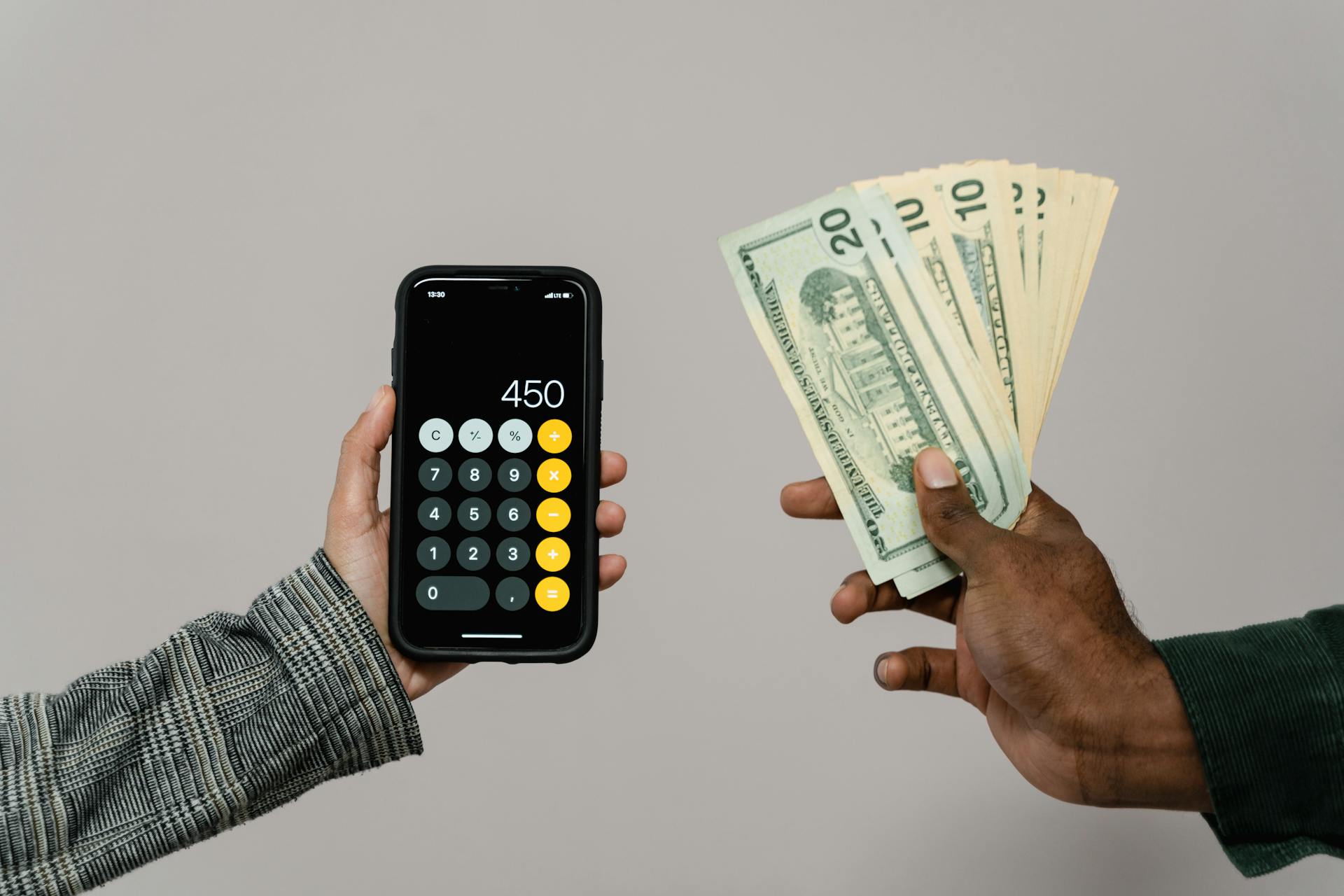
The staggering amount of student loan debt is a burden that many graduates face. In the United States alone, outstanding student loan debt has surpassed $1.7 trillion.
This massive debt has a ripple effect on the economy and individuals alike. The average student loan debt per borrower is over $31,300.
For many, the weight of this debt can be overwhelming, making it difficult to make ends meet. The total amount of student loan debt has increased by over 50% in the past decade.
As a result, students are delaying major life milestones, such as buying a home or starting a family, due to the crushing financial burden.
Types of Student Loans
Student loans can be a complex and overwhelming topic, but let's break it down to the basics. Federal student loans are available with more favorable terms than most private loan options, and they're unique in that payments are deferred while you're a student.
There are two main types of federal student loans: subsidized and unsubsidized Stafford loans. Subsidized Stafford loans are available only to students with financial need, and they don't accumulate interest payments while you're in school or during a six-month grace period after graduation.
Subsidized Stafford loans offer the best student loan deal available, with low interest rates and no interest payments while you're in school. However, eligible undergraduate students can only take out a total of $23,000 in subsidized loans, with limits of $3,500 in the freshman year, $4,500 in the sophomore year, and $5,500 junior year and beyond.
Unsubsidized Stafford loans, on the other hand, offer the same low interest rate as subsidized loans but without government-funded interest payments. This means interest accumulates while you're in school and is then added to your principal balance after graduation.
Graduate and professional students can only take out unsubsidized Stafford loans, with a total limit of $138,500, including loans taken out for undergraduate study. The interest rate for unsubsidized graduate loans is 8.08% for the 2024-2025 academic year.
Stafford
Stafford loans are the federal government's primary student loan option for undergraduates.
They offer a low origination fee of about 1% of the loan and the lowest interest rates possible, currently 6.53% for the 2024-2025 academic year.
The interest rate does not depend on the borrower's credit score or income, making it a more stable option.
There are two types of Stafford loans: subsidized and unsubsidized.
Subsidized Stafford loans are available only to students with financial need and do not require interest payments while you're in school or during a six-month "grace period" after graduation.
Subsidized loans have a ceiling of $23,000, with a maximum of $3,500 for freshman year, $4,500 for sophomore year, and $5,500 for junior year and beyond.
Unsubsidized Stafford loans offer the same low interest rate as subsidized loans but without government-funded interest payments, resulting in accumulated interest added to the principal balance after graduation.
The cumulative total of unsubsidized and subsidized combined that any one student can take out is limited, with dependent undergraduate students capped at $31,000 and financially independent students at $57,500.
Graduate and professional students can no longer get subsidized loans, but can take out $20,500 each year for a total of $138,500, including loans taken out for undergraduate study.
Private
Private student loans can be a good option for students who have exhausted their federal loan options.
They generally offer less favorable terms than federal loans and can be harder to obtain.
Variable interest rates can be higher than 8-10%, and the interest rate can depend on your credit record.
Private loans often require you to go through the full underwriting process, including checking credit histories and debt-to-income ratios.
Private student loans are not subsidized, so interest payments usually must be made for the life of the loan.
Interest rates are higher than subsidized student loans, but still relatively low in the world of private loans.
Some students may find that federal loans can't cover all the costs associated with college, making private loans a necessary option.
Private student loans can be used to help pay for education, but rates tend to be higher and are more likely to be variable rather than fixed.
Having a parent cosign a private student loan can result in better rates, since parents tend to have better credit histories than their children.
Private student loans can be beneficial because the application process is typically less stringent, funds are available almost immediately, and interest may be tax-deductible.
Choose a Repayment Option
Choosing a student loan repayment option that fits your budget is crucial to avoiding financial stress. You can expect variable rates to range from 4.79% APR to 14.96% APR, or 4.79% APR to 15.22% APR, depending on the lender.
Repaying student debt can be a challenge, especially if you're not earning a high income right away. In fact, 74% of millennials are seriously stressed about their financial circumstances, with borrowing and managing debt being a major concern.
Fortunately, there are alternative solutions to help make student loan payments more manageable. Income-based repayment plans can cap monthly payments based on available income, prolonging the life of the loan but relieving the burden of large payments.
The standard repayment plan is the default option for federal student loans, lasting 10 years with fixed monthly payments. However, other plans like graduated and extended repayment plans may be available, depending on your loan type and amount.
Here are some key features of the major repayment plans for federal student loans:
Keep in mind that all educational loans in the U.S. allow for penalty-free prepayment, so you can always pay more towards your loans if you find yourself financially stable.
Financial Impact
Paying off student loan debt can be a long-term process, taking decades to complete, which is why it's essential to consider the financial impact on your future.
Student debt can significantly affect how much of your monthly salary you have left for long-term financial goals.
Lowering your debt through work-study, working outside of school, or choosing an affordable school can put you at a greater advantage as an incoming student.
Federal loans are the only type of student loan that qualify for income-based repayment plans or forgiveness, making them a more attractive option for those who want to manage their debt.
Paying down debt can leave you with less money for other important expenses, such as saving for retirement or a down payment on a house.
Payment and Forgiveness
If you're struggling to pay off your student loans, there are some payment and forgiveness options available to you. You may be eligible for the Public Service Loan Forgiveness (PSLF) Program if you work for a government or not-for-profit organization and make 120 qualifying payments.
The SAVE plan, introduced by the White House, offers a new income-driven repayment (IDR) option that reduces monthly payments to 5% of discretionary income for undergraduate borrowers. This plan also changes the discretionary income formula to ensure payments are set at $0 per month for an estimated one million low-income borrowers.
Another option is to teach full-time for five consecutive academic years in a low-income elementary school, secondary school, or educational service agency, which can lead to the forgiveness of up to $17,500 on your direct loan or FFEL Program loans.
If you're unsure about your eligibility or have questions about these programs, it's best to check with the Department of Education or your loan provider.
Payoff
Paying off your student loans can be a daunting task, but it's essential to understand your options. The Perkins Loan Program, which ended in 2017, had a payback period of 10 years at a 5% interest rate.
If you're struggling to make payments, consider a student loan calculator to see how long it'll take to pay off your loans. Variables like your marital status, age, and loan terms go into the equation.
By paying an extra $150 per month, you can pay off your loan in 6 years and 2 months, saving $4,421.28 in interest payments. This is a significant reduction in the total interest paid over the life of the loan.
Here's a breakdown of the two scenarios:
This table highlights the savings of paying off your loan early. It's essential to review your loan terms and explore options for reducing your debt.
Payment Status
You can check the status of your payment online or through the mobile app, usually within 24-48 hours after submitting your payment.
Most payment providers offer a tracking system that allows you to monitor the progress of your payment.
If your payment is delayed, it's likely due to issues with the recipient's bank or a problem with the payment method.
Don't worry, these issues are usually resolved quickly, and you'll receive an update on the status of your payment.
Some payment providers offer a refund guarantee, which means you can get your money back if the payment fails.
This guarantee can give you peace of mind, especially when sending large payments.
In some cases, you may need to contact the payment provider's customer support to resolve an issue with your payment.
They'll be able to help you troubleshoot the problem and get your payment back on track.
Forgiveness
Federal student loans offer several forgiveness programs, but they're not the same for everyone. You might qualify for debt forgiveness if you're employed by a government or not-for-profit organization through the Public Service Loan Forgiveness (PSLF) Program.
If you teach full-time for five consecutive years in a low-income school, you could be eligible for up to $17,500 in loan forgiveness. This applies to direct loans and FFEL Program loans. Some universities may also offer forgiveness if they close while you're enrolled.
State student loans can also have forgiveness programs, but they vary greatly from state to state. Each state decides what's forgivable, often for industries like nursing or teaching. You'll need to check with your state's department of post-secondary education for details.
Some federal programs offer forgiveness after a certain number of years or payments. The SAVE plan, for example, reduces monthly payments to 5% of discretionary income and provides loan forgiveness after 10 years for those with balances of $12,000 or less.
If You're a Cosigner
If you're a cosigner, it's essential to understand your role and responsibilities. You'll need to grasp what it means to be a cosigner and why it might be the right option for you.
As a cosigner, you'll be responsible for making loan payments if the borrower defaults. Make sure you fully understand the terms and conditions of the loan before signing on the dotted line.
Get familiar with the student loan repayment calculator to estimate monthly payments. This tool can help you plan and budget for the loan.
You can also receive your FICO Score monthly after the first loan disbursement, if you have an available FICO Score and a Sallie Mae-serviced loan with a current balance greater than $0.
If you're struggling to make payments, you may be eligible for the Grace Repayment Plan (GRP). This plan allows interest-only payments for the initial 12-month period of repayment, but be aware that the loan term is not extended.
If approved for GRP, the Current Amount Due will be higher than it otherwise would have been, and the total loan cost will increase.
Understanding Debt
Student loan debt can be overwhelming, with the average borrower owing over $31,300.
High interest rates can make it difficult to pay off debt, with some loans carrying rates as high as 8.5%.
It's essential to understand the different types of debt, including federal and private loans, as well as the impact of defaulting on your credit score.
What Is
PLUS Loans are a type of federal student loan available to graduate and professional students, as well as parents of undergraduate students. They can be used to pay the full cost of attendance, minus any other financial aid received.
The interest rate for PLUS loans is 9.08% for the academic year 2024-2025, and the origination fee is about 4.3%. A credit check is also required, which may make it difficult for students with bad credit to qualify.
PLUS loans can be used to cover a wide range of expenses, including tuition, housing, books, and administrative fees.
Here are some key characteristics of PLUS loans:
State student loans, on the other hand, are offered by individual states and can vary greatly in terms of their features and requirements. Some state student loans may have forgiveness programs, but these are typically reserved for students who remain in the state after graduation and work in fields like nursing or teaching.
What Happens to My Debt if I Don't Graduate?
If you don't graduate, you'll still have to pay off your student loans. For most federal student loans, repayment starts six months after you leave college or drop below half-time enrollment.
Don't assume you can just walk away from your loans if you don't graduate – all student loans must be repaid, regardless of your graduation status.
If You're
If you're a student, it's essential to understand private student loans before you apply. Private student loans can have different terms and conditions than federal student loans.
You should consider whether you need a cosigner for your private student loan. Not everyone can cosign, and it's crucial to understand the responsibilities that come with it.
To graduate with less student loan debt, explore options like income-driven repayment plans or loan forgiveness programs.
Using a student loan repayment calculator can help you estimate your monthly payments and create a budget.
Calculator
The Student Loan Calculator is a useful tool to estimate the loan balance and repayment obligation after graduation. It's mainly for those still in college or who haven't started yet.
You can use the calculator to see how much you'll need to pay each month and how much interest you'll accumulate over time. For example, if you borrow $40,000, your monthly repayment could be as high as $526.96.
The calculator also shows the total interest you'll pay over the life of the loan, which can be a staggering $23,234.95 in this case. This is why it's essential to use the calculator before taking out a loan.
To make your loan more manageable, you'll need to earn at least $45,790 per year or more. This will help you cover the loan payments and other living expenses without too much stress.
Here are some key statistics to keep in mind:
Frequently Asked Questions
Is $60,000 in student loan debt a lot?
According to recent data, graduating with over $60,000 in student loan debt is considered a significant amount, as it affects only 4% of public university graduates. However, the majority of students graduate with much lower debt levels, with 78% owing less than $30,000.
What is the total student loan debt in 2024?
As of June 2024, Americans owe approximately $1.6 trillion in student loans. This staggering debt has increased by 42% over the past decade.
What is the average college debt after 4 years?
The average college debt after 4 years is $35,530, with varying costs depending on whether you attend a public or private college. Find out how your college choice affects your debt.
How many student loan borrowers owe more than $100,000?
About 1% of all U.S. adults owe at least $100,000 in student loans, while 26% of those with advanced degrees who borrowed also owe this amount.
How many Americans have over $1,000,000 in student debt?
According to the Education Department, approximately 101 Americans owe over $1 million in federal student loans, a significant increase from the 14 individuals who owed this amount five years ago.
Sources
- https://www.federalreserve.gov/publications/2022-economic-well-being-of-us-households-in-2021-student-loans.htm
- https://www.salliemae.com/student-loans/
- https://www.investopedia.com/terms/s/student-debt.asp
- https://smartasset.com/student-loans/student-loan-calculator
- https://www.calculator.net/student-loan-calculator.html
Featured Images: pexels.com


